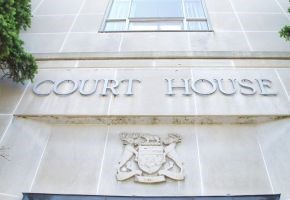Tire marks from a 2002 accident that claimed the lives of a mother and her two sons painted a violent picture, according to engineer and crown witness Alan Billing, who took the stand Tuesday during the Michael Hickey trial.
Hickey is charged with three counts of criminal negligence causing death after his tractor-trailer flipped on Highway 69, near the Killarney turnoff, and impacted the car driven by Kelly Ann Henderson. Her twin 12-year-old sons, Corbin and Jordin Sauve, were passengers. All three perished in the Aug. 7, 2002 accident.
Billing, a professional engineer with a firm in Toronto, made calculations according to measurements from the fatal crash sent to him by the OPP.
Billing has experience in many areas of collisions, including rollovers and the design of roads.
He determined that the curve, which begins about 100 metres south of the Killarney turnoff, where the collision took place, has a radius of 433 metres and was designed with a maximum safe speed of 100 km/h by the Ministry of Transportation. The posted speed is 90 km/h, which means if a person is driving at the limit, they are within safety speed, said Billing.
From the information obtained by investigators, Billing studied three groups of tire marks that are said to be from the tractor-trailer and lead up to its resting place.
According to the engineer, the marks go from “from less violent to more violent.”
The first group of tire marks, furthest away from the final resting place, were less prominent than the other two sets, said Billing. The marks were made from the rear and middle axles on the vehicle.
“It is not a breaking or skid mark,” said Billing.
The second group of tire marks have parts that extend past the centre line, he stated. This group of tire marks is heavier and easier to see than the previous.
The third set of tire marks were split clearly into three separate marks, corresponding to each axle on the trailer. The sudden change in the character of the marks indicates where the rollover took place, he said.
Normally, the axles on a trailer would be equally spread, continued Billing.
“The middle axle is longer than the other two axles,” he said.
The three tires that left the tire marks on the asphalt should have been supporting one-quarter of the trailer's weight, but were supporting all of it, he continued. The progression of prominence in the tire marks does not necessarily mean an increase in speed, said Billing.
According to the engineer, the tire marks are indicative of the trailer swinging out to the left three times, the third time resulting in a rollover.
“Each time, the forces are getting greater,” he said.
According to Billing, the angle of the tractor, which was pointed toward the shoulder, was most likely caused by the trailer's movements and not by the driver's actions behind the wheel.
Wednesday's court proceedings were to continue with Billing once again taking the stand. The Crown is expected to finish its witness list within a couple of days.



